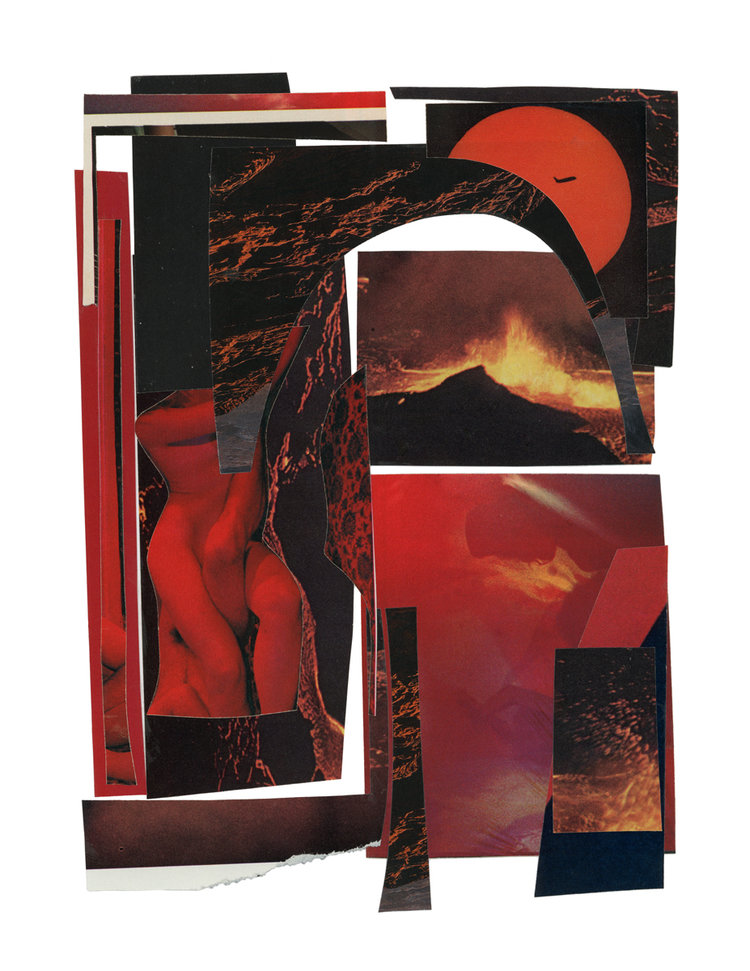Interview by Monica Z. Stefanie Cortazzo is multimedia artist who recently exhibited her series “Cosmic Crisis” with the Brooklyn Collage Collective this past summer in Bushwick. She talks about her intention and relationship to the medium.
Private Bodies: A Conversation with Stephanie Cortazzo – Featured Artist in the Brooklyn Collage Collective
KB: Are you attempting to generate a discourse on public and private bodies, in particular women’s bodies in intimate settings? Is there a feminist context to “Purple Rain” – specifically, in relation to the abject woman whose violent, jerking, bodily gestures are considered ghastly or shocking by the patriarchy?
The female protagonists in my collages, set in dystopian universes, struggle to make sense of their environment. The elements of natural disaster allude to the chaotic and fucked up world these women have to endure. The violent reactions of these characters are meant to show their discontent in their situations, tormented by the grip of man.
KB: There is an element of dystopia in this series, which, speaking of the times we live in, we can’t really deny. The piece, “Multi Love” (Figure 1) reads as if it is from someone’s traumatic memory or nightmare, and at the same time there this language of feeling—the ruins of love and dating in all its pathos. How does your emotional essence, in particular feelings of love and crisis, figure into your work? Is there a specific dialogue you are trying to generate with yourself or the wider audience?
I think the conversation I’m trying to have and something I personally think about often is the challenge of honoring your soul and the power issues that dominate the exchange of two souls. In my work, I’m piecing together a scenario that could be anyone’s; the feeling of unrest that comes with being vulnerable and sharing your heart with another person. In Multi Love the main character is stuck in a nightmare. In some sense, she is a voyeur, looking through to multiple unclothed bodies with both elation and discontent. Let’s image her lover is entangled in the pile of bodies. She is threatened by his attention for others and is torn as to if she should demand his “love” or ignore feelings and join him in multiplicity. I would definitely say I’ve inserted my personal experiences in this work to speak to my own uncertainty and skepticism on monogamy. I am at a point in my life where I am trying to honor my soul while navigating healthy romantic relationships without feeling like I have to agree with our cultures idea that two people are “meant to be.”

Initially, collage was a way for me to step outside photography. I was frustrated by the mechanics of the camera. Yes, the camera as a device can be very nuanced but ultimately, I felt reduced by the act (clicking the shutter can be very anticlimactic) and wanted to engage my body more in the process of making art.
Photography is in the midst of a historic shift where the photographic image no longer has to be synonymous with camerawork. Collage presented the best case for me to bring physicality to my art practice; to rip, slash, tear, cut and paste while still working with photo based images. I became mesmerized with the process of assemblage and found that the workflow was almost machine like.
During spurts of depression, I would use collage as therapy centering all my focus on sourcing material and making specific cuts. It was so beneficial for distracting my mind from anxiety. I was keeping busy for hours at a time using my eyes and hands in tandem – it felt incredible. Flipping through my source material preoccupied my obsessive-compulsive desire to collect. I like to look at as much as I can at one time so sifting through magazines and paper backs has been a lot of fun and I’m pretty pleased with my collection.
KB: You work in different mediums like painting and photography, as well as collage – before coming to your exhibit Id rarely see collage art in galleries or museum. Does the impression of collage as not a serious form of art bug you at all?
Yeah, totally. The thing is that collage is fairly new to the game. Assemblage has been explored since around 1910; that’s just over 200 years of exploration versus paintings 40,000 years.
Collage literally means, “to glue” – something that anyone can do, not just a skilled artist or craftsman so I think the tangibility and accessibility of the medium doesn’t help collages “low art” stigma. But that’s what I love so much about it; I can take contrive a work from a bus ticket, magazine clippings, book page, receipt paper, and weave a new narrative of my own kind.
The detritus of “modern” life wasn’t seen as precious in art because of its organic matter and ability to decompose. Collage was seen as a throw away form and so the notion that it was less preservable added to the idea that it was cheap. Collage has endured a long history of anti-art mocking vs. permanence and importance of museum art. However it was largely influenced Cubism, Dada and Surrealism! The medium deserves a willing and enthusiastic eye. Collage is unique in that it essentially has no limitations. Collage is everything else and itself.
For more work from Stephanie Cortazzo, visit: www.stephaniecortazzo.com
www.instagram.com/loosechange___
interview by mzandi.tumblr.com or @chernobyldiaries_





